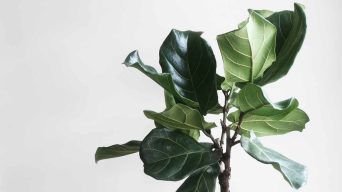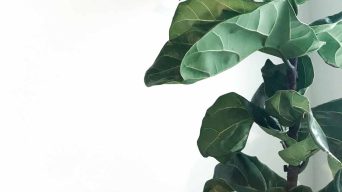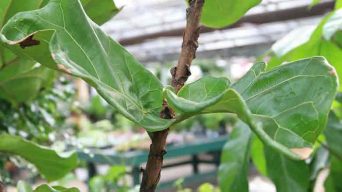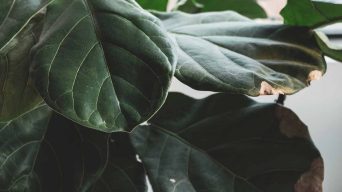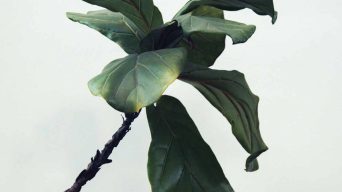The fiddle leaf fig (Ficus lyrata) is a popular houseplant known for its large, glossy leaves.
They’re relatively easy to care for, but like all plants, they can sometimes develop problems.
One problem that fiddle leaf figs are susceptible to is black spots on the leaves.
There are several reasons why black spots might develop on fiddle leaf fig leaves.
To solve the problem, it’s essential to figure out what is causing the black spots in the first place.
What Causes Black Spots on Fiddle Leaf Fig Leaves and How Can You Fix It?
Fiddle leaf figs are beautiful plants that can brighten up any room.
But sometimes, their leaves develop black spots.
The most common causes of black spots on fiddle leaf figs are overwatering, fungal diseases, or pests.
Most of these problems can be fixed with a little bit of effort.
Here are a few of the most common causes of black spots on fiddle leaf figs and what you can do to fix them:
1. Overwatering
Overwatering is one of the most common reasons for black spots on fiddle leaf figs. It is the act of providing too much water to a plant.
This can be done by watering too frequently or not allowing the plant’s soil to dry out completely between waterings.
Overwatering can damage plants in several ways.
When a plant is overwatered, the roots start to rot.
This prevents the plant from taking up water and nutrients properly, which can cause the leaves to turn yellow or brown and eventually drop off.
Excess water can also encourage fungal growth, further damaging plant health.
How To Treat an Overwatered Fiddle Leaf Fig
If you think your fiddle leaf fig is overwatered, the first thing you should do is stop watering it for a while.
Let the plant’s soil dry out thoroughly before you water it again.
You can then start watering your fiddle leaf fig tree less frequently.
Water it only when the top inch of soil is dry to the touch.
If the black spots on the leaves don’t start to improve after a week or two, you may need to repot the plant.
Use a well-draining potting mix and make sure the pot has drainage holes.
2. Fungal Diseases
Fungal diseases are another common cause of black spots on fiddle leaf figs.
These diseases are usually caused by too much moisture from overwatering or high humidity.
The most common fungal diseases affecting fiddle leaf figs are black spot, leaf spot, sooty mold, and anthracnose.
Black Spot Fungus
Black spot fungus is the most common fungal disease affecting fiddle leaf figs.
This disease appears as black spots on the leaves, usually surrounded by a yellow halo.
The spots can range from a few millimeters to a few centimeters.
Black Spot Fungus is spread by water droplets, and thus wet weather or watering techniques that splash water on the leaves can contribute to its spread.
The fungus thrives in warm, humid conditions, making it a common problem in greenhouses or during the summer months.
How To Treat Black Spot Fungus
If you think your fiddle leaf fig has black spot fungus, the first thing you should do is remove any affected leaves.
You can then try to improve air circulation around the plant and ensure the leaves are dry before watering.
Watering early in the day can also help, giving the leaves time to dry before nightfall.
You can use a natural fungicide to treat the plant if the problem persists.
Neem oil and horticultural oil are both effective against black spot fungus.
Fungal Leaf Spot
Leaf spot fungus is another fungal disease that can affect fiddle leaf figs.
Fungal leaf spot is a type of plant disease that is caused by a variety of different fungal pathogens.
These fungi typically attack the leaves of a plant, causing black or brown spots to form on the leaf surface.
In severe cases, the spots can coalesce and cause the entire leaf to turn brown and die.
How To Treat Fungal Leaf Spot:
To treat fungal leaf spot, you must remove any affected leaves from the plant.
You can treat the plant with a natural fungicide, such as neem oil or copper fungicide.
Make sure to follow the instructions on the fungicide label you are using.
You should also take steps to improve the drainage of your plant’s potting mix and ensure that the plant is not getting too much water.
Sooty Mold
Sooty mold is a type of fungi that often affects plants that have been infested with aphids or other sucking insects.
The insects excrete a sticky substance known as honeydew, which the sooty mold fungus uses as food.
As the fungus grows, it covers the plant leaves in a black, sooty-looking substance.
Sooty mold does not typically directly damage the plant leaves, but it can block sunlight and cause the leaves to turn yellow or brown.
How To Treat Sooty Mold
If you think your fiddle leaf fig has sooty mold, the first step is to address the underlying problem: the infestation of aphids or other sucking insects.
Remove the insects from your plant by spraying them with water or using insecticide soap.
Once the insects are gone, the sooty mold will eventually fade away on its own.
However, you can speed up the process by washing the leaves of your plant with a mild soap and water solution.
Anthracnose
Anthracnose is a type of plant disease that can affect many plants, including fiddle leaf fig trees.
The disease is caused by a fungus infecting the plant through open wounds or natural openings such as stomata.
Once the fungus has taken hold, it produces spores that are spread by wind or water to other plants.
Anthracnose often affects plants during periods of wet weather, when the spores are more likely to germinate.
Anthracnose symptoms include black or brown spots on the fiddle leaf fig leaves, premature leaf drop, and stunted growth.
In severe cases, the fungus can kill the plant.
How To Treat Anthracnose on Fiddle Leaf Fig
If you think your fiddle leaf fig has anthracnose, the first step is to isolate the plant from other plants in your home.
This will help prevent the disease from spreading. Next, remove any affected leaves and dispose of them.
You can also try treating the plant with a natural fungicide.
Neem oil is a popular option, as it is safe for humans and pets and does not harm the environment.
Mix neem oil with water according to the instructions on the bottle, and then spray the mixture onto the affected leaves.
Be sure to cover the entire leaf, including the underside.
You must treat your plant every 7-10 days until the symptoms disappear.
You can also do a few things to prevent anthracnose from occurring in the first place.
Ensure your fiddle leaf fig has plenty of space to grow, and avoid over-crowding it.
Keep the plant well-watered, but don’t allow it to sit in water.
Water early in the day so the leaves have time to dry before nightfall.
And finally, make sure to Sterilize your gardening tools after each use.
3. Bacterial Infection
Bacterial infections are another plant disease that can affect fiddle leaf figs.
Many different types of bacteria can infect plants, and each one can cause different symptoms.
Some common signs of plant bacterial infection include wilting, yellowing leaves, stunted growth, and black or brown spots on the leaves.
In severe cases, the entire plant may die.
Bacterial infections are often spread by insects or through contact with infected soil or water.
The most common bacterial diseases that cause black spots on fiddle leaf figs are bacterial leaf spot and bacterial blight.
How To Treat Bacterial Infection on Fiddle Leaf Fig
If you think your fiddle leaf fig has a bacterial infection, the first step is to isolate the plant from other plants in your home.
This will help prevent the disease from spreading. Next, remove any affected leaves and dispose of them.
You can also try treating the plant with a natural bactericide.
Baking soda is a popular option, as it is safe for humans and pets and does not harm the environment.
Mix 1 teaspoon of baking soda with 1 quart of water, and then spray the mixture onto the affected leaves.
Be sure to cover the entire leaf, including the underside.
You must treat your plant every 7-10 days until the symptoms disappear.
You can also do a few things to prevent bacterial infections from occurring in the first place.
Make sure your fiddle leaf fig has enough ventilation.
Leafy plants like this one often benefit from being placed near an open window or door.
Water your plant regularly, but be sure not to overdo it. Allowing the soil to dry out between waterings will help prevent bacteria from taking hold.
Finally, avoid placing your plant in direct sunlight, which can cause the leaves to scorch and become more susceptible to disease.
4. Viral Infection
Viral infections are another possible cause of black spots on fiddle leaf figs.
While most viruses are not harmful to plants, some can cause problems.
Viral infections are caused by viruses infecting plant cells and disrupting their normal growth.
These viruses are typically spread by insects or other animals that feed on the plants, and they can cause a wide range of symptoms, from mild leaf discoloration to complete plant death.
A few different viruses can infect fiddle leaf figs, but the most common is the cucumber mosaic virus (CMV).
Symptoms of CMV include black spots on the leaves and yellow or white mottling.
The leaves may also be distorted or have a crinkled appearance.
How To Treat Viral Infections
Unfortunately, there is no cure for viral infections, and affected plants must be destroyed.
To prevent the spread of viruses, it is essential to practice good hygiene when handling infected plants.
Always wash your hands after handling them and disinfect any tools you use.
You should also avoid contact with other plants until you have cleaned up.
5. Pests
Pests are another common problem that can cause black spots on fiddle leaf figs.
Many types of pests can attack plants, but the most common ones affecting fiddle leaf figs are aphids, scale insects, and spider mites.
These pests feed on the plant’s sap, which can cause several problems, including leaf discoloration, stunted growth, and black spots on the leaves.
Pests can also spread diseases, so it is crucial to control them as soon as possible.
How To Control Pests
You can control pests on your fiddle leaf fig in a few different ways.
The first step is to isolate the plant from other plants in your home. This will help prevent the pests from spreading.
Next, you can try treating the plant with a natural pesticide.
There are many different recipes that you can find online, but one simple option is to mix 1 cup of water with 1 tablespoon of dish soap.
Spray the mixture onto the affected leaves, covering the undersides as well.
You must treat your plant every 7-10 days until the symptoms disappear.
You can also try using a commercial pesticide, but be sure to choose one safe for indoor plants.
Some products that contain neem oil or pyrethrin are effective against many common houseplant pests.
How To Prevent Black Spots on Fiddle Leaf Fig
You can do a few things to prevent black spots from occurring in the first place.
One of the most important things is to provide your plant with proper care.
Here are a few tips:
- Water your plant regularly, but allow the soil to dry out between waterings.
- Place your plant in an area with bright indirect sunlight.
- Ensure the pot has drainage holes to prevent the roots from sitting in water.
- Prune off any dead or dying leaves.
- Avoid placing your plant in direct sunlight, as this can cause the leaves to scorch.
- Be sure to quarantine any new plants before adding them to your collection.
- Remove any infected leaves from your plant as soon as you see them.
- Disinfect any tools that you use on your plant.
By following these tips, you can help prevent black spots from occurring in the first place.
Final Thoughts
Black spots on fiddle leaf figs are usually caused by a few problems, including overwatering, fungal diseases, bacterial infections, viral infections, or pests.
Most of these problems can be controlled with proper care and treatment.
If you notice black spots on your Ficus lyrata plant, take action immediately to prevent the problem from getting worse.
With some care, you can keep your fiddle leaf fig healthy and free from black spots.


